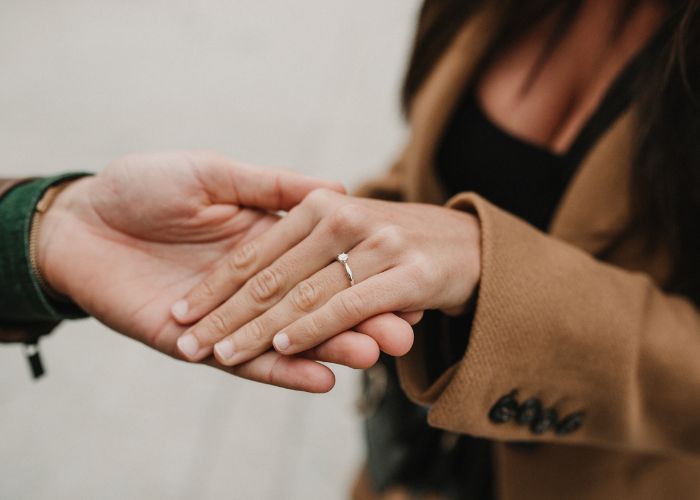Hey There! We may earn a commission from links on this page. This helps support the site and is at no extra cost to you. Thanks!
An engagement ring is more than just jewelry; it symbolizes commitment and a narrative of love shared between two people. When I consider helping someone choose the right gemstone for their ring, I treat it with the reverence it deserves.
Every gemstone carries its own set of characteristics and meanings, which can profoundly influence the symbol that the engagement ring becomes. It’s not just about the sparkle or the color; it’s about what lasts, what has value, and what speaks to the story you want to tell.
This article aims to provide well-researched, accurate, and helpful advice. Whether you’re drawn to the traditional elegance of diamonds or the unique charm of sapphires, I’ll guide you through making a selection that’s both informed and heartfelt.
This guide breaks down the essentials: from considering your day-to-day life while posing the question, ‘How often will you wear the ring?’ to pondering the emotional resonance a gemstone’s color may bring to your life. My goal is to help you create a ring that’s as durable as it is delightful—a fitting tribute to the longevity of your love.
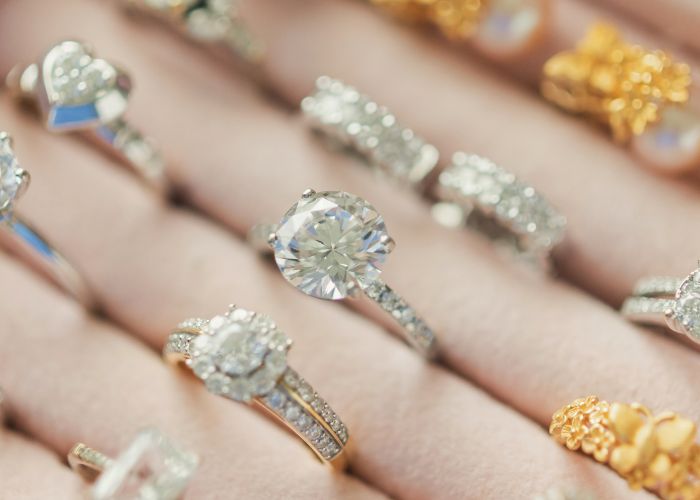
Reflecting Your Lifestyle in Your Ring’s Design
An engagement ring isn’t merely a piece of jewelry; it’s a testament to your daily journey together, as integral to your routine as your morning coffee. It’s vital, then, that the ring fits seamlessly into your life. You’re not going to change how you live for a ring, so choose a setting that complements your habits and activities.
The setting you select for your engagement ring has to withstand the rigors of your lifestyle. If you’re someone who’s hands-on with gardening, cooking, or sports, a lower profile and less ornate setting can prevent your ring from snagging and reduce wear and tear. In contrast, if your day-to-day is less physically demanding, a more elaborate setting might suit you perfectly.
There are several engagement ring settings to choose from, each with its own advantages and disadvantages.
Below are some popular settings to consider:
1. Prong setting: This is the most popular engagement ring setting, where a small metal claw holds the diamond or gemstone in place. The pros of this setting are that it allows maximum light to enter the stone, giving it a brilliant sparkle. However, the cons are that the prongs can sometimes snag on clothes or hair and may require regular maintenance to keep the stone secure.
2. Bezel setting: In this setting, a metal rim encircles the diamond or gemstone, holding it in place. The pros of this setting are that it provides good protection for the stone from damage and is ideal for people with active lifestyles. However, the cons are that it may not allow as much light to enter the stone, which can affect its brilliance.
3. Tension setting: This type of setting holds the diamond or gemstone in place by applying pressure from the sides. The pros of this setting are that it provides a modern and sleek look to the ring, and the stone appears to be floating in the air. However, the cons are that it requires a high level of skill to create and adjust, and the stone may become loose over time.
4. Halo setting: In this setting, a circle of smaller diamonds or gemstones surrounds the center stone, giving it a halo effect. The pros of this setting are that it enhances the sparkle of the center stone, giving it a larger appearance. However, the cons are that the smaller stones may require regular cleaning to maintain their shine.
5. Channel setting: In this setting, diamonds or gemstones are set into a channel in the ring band. The pros of this setting are that it provides good protection for the stones and gives the ring a sleek and modern look. However, the cons are that it can be challenging to resize the ring, and the stones may become loose over time.
6. Pavé setting: This type of setting features small diamonds or gemstones set close together, creating a paved effect. The pros of this setting are that it gives the ring a lot of sparkle and enhances the center stone. However, the cons are that the small stones may require regular cleaning to maintain their shine, and the setting may be more delicate than others.
7. Cathedral setting: In this setting, the center stone is held in place by arches that rise up from the band. The pros of this setting are that it provides good protection to the stone and gives the ring an elegant and classic look. However, the cons are that the arches may catch on clothing or hair and may require regular maintenance to keep the stone secure.
8. Bar setting: In this setting, the diamonds or gemstones are held in place by metal bars that run perpendicular to the band. The pros of this setting are that it provides good protection to the stones and gives the ring a modern and sleek look. However, the cons are that it may be challenging to resize the ring, and the stones may become loose over time.
9. Flush setting: In this setting, the diamonds or gemstones are set into the band so they are flush with the surface. The pros of this setting are that it gives the ring a clean and modern look, and the stones are well-protected. However, the cons are that it may be challenging to resize the ring, and the stones may be more difficult to clean.
10. Cluster setting: In this setting, several small diamonds or gemstones are set close together to give the appearance of a larger stone. The pros of this setting are that it provides good protection for the stones and gives the ring a unique and eye-catching look. However, the cons are that the small stones may require regular cleaning to maintain their shine, and the setting may be more delicate than others.
[Read: Types of Vintage And Antique Ring Settings]
Materials matter just as much. Platinum and certain gold alloys offer added durability, which is something to think about if your hands frequently take center stage in your work or hobbies. In the same vein, consider how often you’ll wear your ring. If it’s going to be a constant fixture on your finger, opting for resilience is a SMART CHOICE.
[Read: Unique Rose Gold Engagement Rings on Etsy]
Ultimately, the confluence of your engagement ring’s setting, material, and your daily activities should create a harmonious blend that complements, not complicates, your life. Now, knowing the importance of durability, let’s turn our attention to the gemstones that promise to stand the test of time―those with a high hardness rating.
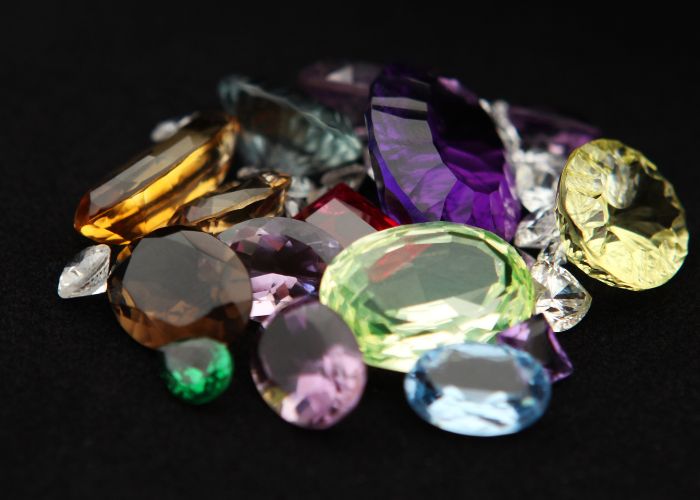
The Longevity of Love: Selecting Hard Gemstones
You want your engagement ring to symbolize your enduring commitment, right? So it makes perfect sense to choose a gemstone that’s up to the task. This is where the Mohs scale of mineral hardness comes in handy. It measures a stone’s ability to withstand surface scratching, and let’s be honest, an engagement ring that scratches easily just won’t do.
Consider this: the higher the rating on the Mohs scale, the more resistant the gemstone is to scratches. Diamonds, for instance, sit at the top with a rating of 10, which is one of the reasons they’re so popular in engagement rings. They’re the ultimate symbol of a love that lasts, not just for a moment, but forever.
But diamonds aren’t the only option. Stones like sapphires and rubies follow close behind on the scale, boasting impressive durability. These gems don’t just offer resilience; they come with their own unique beauty and a rainbow of colors that might just capture your heart.
Here’s a list of some of the hardest gemstones:
- 1. Diamond (10 on the Mohs scale)
- 2. Moissanite (9.25 on the Mohs scale)
- 3. Ruby (9 on the Mohs scale)
- 4. Sapphire (9 on the Mohs scale)
- 5. Alexandrite (8.5 on the Mohs scale)
- 6. Chrysoberyl (8.5 on the Mohs scale)
- 7. Topaz (8 on the Mohs scale)
- 8. Spinel (8 on the Mohs scale)
- 9. Garnet (7.5-8 on the Mohs scale)
- 10. Tourmaline (7-7.5 on the Mohs scale)
However, know that hardness isn’t the only factor. When selecting a gemstone for your engagement ring, it’s important also to consider the gem’s toughness and stability. Toughness refers to the gem’s resistance to breaking or chipping, and stability refers to the gemstone’s ability to withstand changes in temperature, light, and other environmental factors without losing its color or clarity. These three factors create a gemstone’s wearability grade.
The GIA wearability grade ranges from “Excellent” to “Poor” and takes into account factors such as hardness, toughness, and stability. A gemstone with a higher wearability grade will be more durable and resistant to damage than one with a lower grade.
Wearability can be graded as follows:
- Excellent
- Very Good
- Good
- Poor
- Display Only
An “Excellent” wearability grade indicates that a stone is suitable for daily wear. On the other hand, a stone with a wearability grade of “Poor,” such as an opal, requires careful consideration for its use in jewelry. It is advisable to wear it occasionally or use it in protective settings only. “Display only” stones are meant for collections or display purposes and are not recommended for wearing as jewelry.
The following gemstones can be categorized by their wearability grades.
Excellent
These gems are among the hardest materials on earth, making them perfect for everyday wear in rings while maintaining their bright and lustrous appearance for years to come.
- Diamond
- Ruby
- Sapphire
- Alexandrite
- Moissanite
Very Good
These gems are suitable for both engagement rings and daily wear. However, it’s important to be cautious during sports or other activities that could cause scratching or impact.
- Aquamarine
- Morganite
- Blue Topaz
- Amethyst
- Citrine
- Tourmaline
- Garnet
- Lab-Created Emerald
- Onyx
- Spinel
Good
These gemstones are ideal for occasional wear in rings as long as they are treated with care. They are prone to becoming dull due to scratches caused by quartz particles in household dust. However, they can be polished to restore their original shine and luster. It’s important to note that these gemstones are more susceptible to chipping or cracking than others.
- Tanzanite
- Peridot
- Zircon
- Cubic Zirconia
Delicate
We recommend these for occasional wear. Take extra care to avoid chemicals, extreme temperatures, and low humidity. They’re best suited for pendants and earrings, which are less likely to suffer impacts or scratches.
It’s important to choose a gemstone well-suited to your lifestyle and daily wear habits to ensure that your engagement ring lasts for years to come.

A Spectrum of Stones: Types and Their Characteristics
Choosing the right gemstone for an engagement ring is much like picking a partner for life; you want it to complement your style, endure through the ups and downs, and represent your unique bond. While diamonds have traditionally held the spotlight, various other gemstones have emerged as worthy contenders, each with their distinct appeal. Here, I delve into the pros and cons of some popular types, helping you find a gem that’s not just physically stunning but also resonates with your values and desires.
Sapphires, for instance, are second only to diamonds in hardness, offering a robust option for those who lead an active lifestyle. Their spectrum of colors, from the beloved deep blue to the rare pink, enables personal expression. Yet, they can be pricey and may require a careful eye to ensure quality in color and clarity.
[Read: 10 Best Sapphire Engagement Ring Shops on Etsy]
Rubies, exuding a fiery red, symbolize passion and are nearly as hard as sapphires. Their boldness commands attention, making a statement ring that stands out. However, this boldness can come at a cost, with high-quality rubies being as expensive, if not more so, than diamonds.
[Read: Buyers Guide to Vintage Ruby Engagement Rings]
Emeralds present a lush green that’s hard to miss and are often associated with wealth and royalty. But their beauty is accompanied by greater care requirements since they are softer and more prone to scratching. Their inclusions, known as jardin (French for garden), add character but also present a risk for fractures.
[Read: How to Buy Emerald Jewelry Online]
Aquamarines offer a tranquil blue that reflects a calm and harmonious relationship. They are relatively hard but may not suit someone seeking a standout color, as their pastel tones can appear subdued.
[Read: Aquamarine Vintage Engagement Rings – A Buying Guide]
Ultimately, our choice has to balance the visual aspects you love with the gemstone’s practicality for daily wear. In the next section, I’ll help you zero in on what color speaks to you and how it ties intimately with your personal narrative.
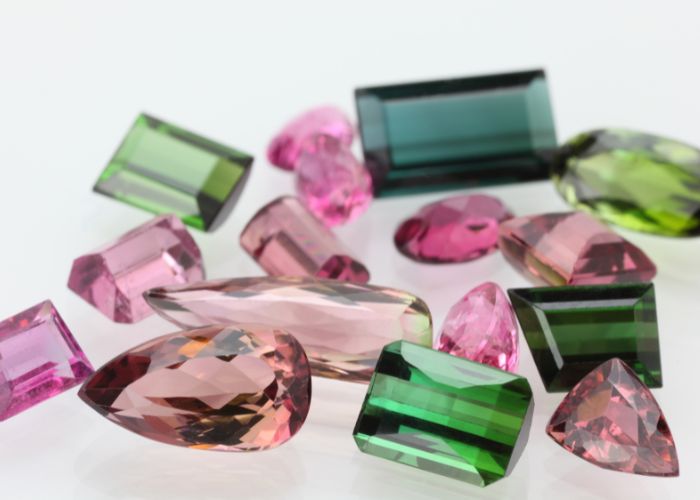
Color Me Committed: Choosing a Hue That Resonates with You
Engagement rings are more than sparkling pieces of jewelry; they’re symbols of love and commitment. The color of the gemstone you choose plays a vital role in expressing your unique bond and personal style. While diamonds are a traditional choice, they’re not the only option. In fact, colorful gemstones have become increasingly popular for their distinctive charm and the way they can personalize a ring.
Every color carries its own psychological impact—some evoke tranquility, others passion. It’s essential to consider what feelings the gemstone’s hue brings to you. Does a velvety blue sapphire calm your spirit, or does the vibrant red of a ruby ignite a fire within you? Think about the emotions associated with different colors and how these align with the essence of your relationship.
[Read: How to Buy Pink Diamonds – Everything You Need to Know]
Now, I encourage you to explore your preferences. What colors are you drawn to in your daily life? Perhaps there’s a shade you consistently pick when choosing clothing or decorating your home. This color could be the one that represents your love in its truest form when set into an engagement ring.
[Read: 9 Best Black Diamond Engagement Ring Shops on Etsy]
The choice of color is deeply personal and contributes to your ring’s narrative—not just in how it complements your finger, but how it tells your story. Align this with your personal experiences and shared memories. Did you meet under a golden sunset? Then maybe a citrine or yellow sapphire speaks to your heart. Your shared experiences can be reflected in your chosen color, making it an extension of your love story.
[Read: How to Buy Yellow Diamonds – An Informative Guide]
Remember, the gemstone you select will be a daily reminder of your commitment. Ensure it’s a color that brings you joy and resonates with the depth of your feelings. Stepping beyond the purely aesthetic, the chosen hue should be one that you connect with emotionally, so that each glance at your hand brings a smile to your face and warmth to your heart.
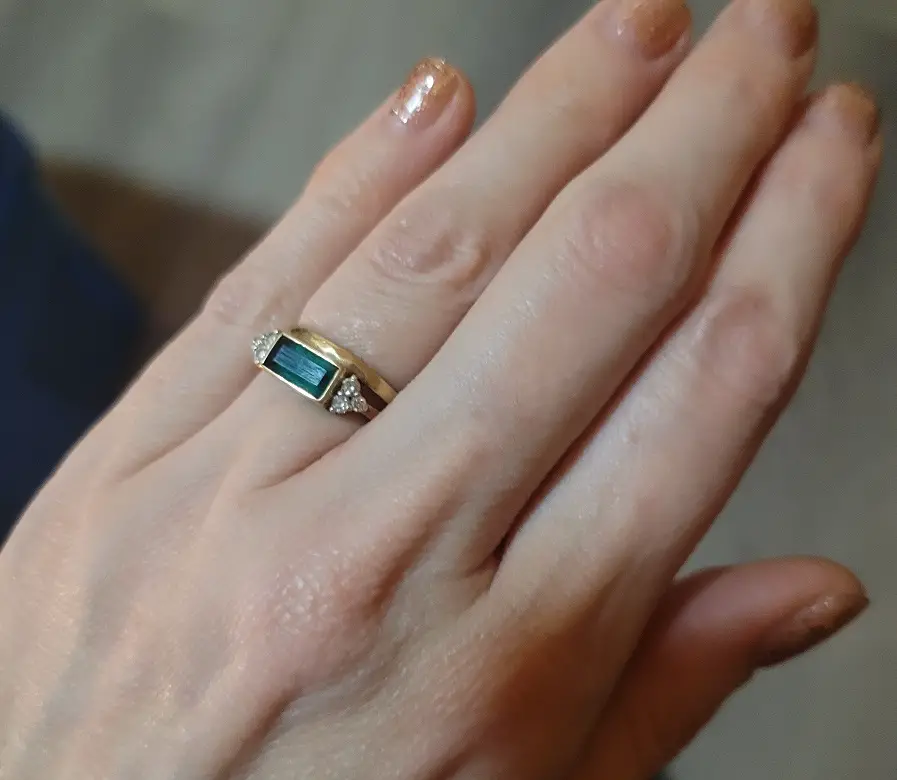
My Engagement Ring Selection
When I shopped for my engagement ring, I knew I wanted something I could wear daily. I am a busy person who does a lot with her hands every day. I do dishes, clean, cook, care for kids, garden, and farm.
I knew I wanted a bezel setting to protect whatever gemstone I chose. I knew I wanted something other than a diamond. I researched other hard stones and their meanings. I selected an emerald because it was high on the Mohs hardness scale and because the meaning of the gemstone resonated with me and my love.
I actually didn’t consider the wearability grade of my stone; I wasn’t aware of that grading when I was researching for my ring; it was when I started researching for this article that I learned about it. So, in hindsight, an emerald may not have been the best choice.
I also ended up getting a ring with small, prong-set diamonds on the edges of the bezel-set emerald because I was very drawn to their sparkle. My husband bought the ring for me on Etsy. I wore my ring every day until I got married, and unfortunately, I did have a diamond fall out 🙁 Luckily, the jeweler that made my ring replaced it for free. I assume my ring got snagged on something, and the diamond came out. So now I don’t wear that ring every day. I should have stuck with just the emerald or got a bezel-set diamond. I still love my ring; it’s beautiful, but it’s not for daily wear with my lifestyle.
[Read: The Best Engagement Ring Shops on Etsy]
Conclusion
Ultimately, your engagement ring is a symbol of your unique bond and shared future. It doesn’t have to conform to trends or conventions, as long as it’s a true representation of the emotions you carry for one another. Listen to your instincts and let your personal joy and connection with the gemstone steer your decision. After all, this ring is a testament to your relationship’s journey, a piece that will be cherished for a lifetime.

